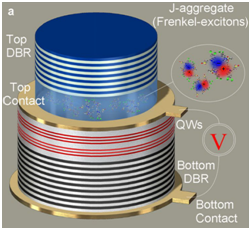Hybrid Organic-Inorganic Microcavities
 Organic materials exhibit exceptional room temperature light emitting characteristics and enormous exciton oscillator strength, however, their low charge carrier mobility prevent their use in high-performance applications such as electrically pumped lasers. In this context, ultralow threshold polariton lasers, whose operation relies on Bose-Einstein condensation of polaritons – part-light part-matter quasiparticles, are highly advantageous since the requirement for high carrier injection no longer holds. Polariton lasers have been successfully implemented using inorganic materials owing to their excellent electrical properties, however, in most cases their relatively small exciton binding energies limit their operation temperature. It has been suggested that combining organic and inorganic semiconductors in a hybrid microcavity, exploiting resonant interactions between these materials would permit to dramatically enhance optical nonlinearities and operation temperature.
Organic materials exhibit exceptional room temperature light emitting characteristics and enormous exciton oscillator strength, however, their low charge carrier mobility prevent their use in high-performance applications such as electrically pumped lasers. In this context, ultralow threshold polariton lasers, whose operation relies on Bose-Einstein condensation of polaritons – part-light part-matter quasiparticles, are highly advantageous since the requirement for high carrier injection no longer holds. Polariton lasers have been successfully implemented using inorganic materials owing to their excellent electrical properties, however, in most cases their relatively small exciton binding energies limit their operation temperature. It has been suggested that combining organic and inorganic semiconductors in a hybrid microcavity, exploiting resonant interactions between these materials would permit to dramatically enhance optical nonlinearities and operation temperature.
In this project, we aim at creating cavity mediated hybridization inorganic semiconductor excitons such as GaAs and GaNwith organic or perovskite excitons in the strong coupling regime[1]. We aim at implementing electrical carrier injection via high mobility inorganic semiconductor to demonstrate low threshold, room temperature and broadly tunable polariton lasers. The new hybrid organic-inorganic microcavitydevices willutilize organic component for sustaining high temperature polariton condensation and efficient electrical injection through inorganic structure.
[1] G Paschos, et al., Scientific Reports 7, 11377 (2017)
[2] R. Jayaprakash et al., Light: Science & Appl. 8, 81 (2019)